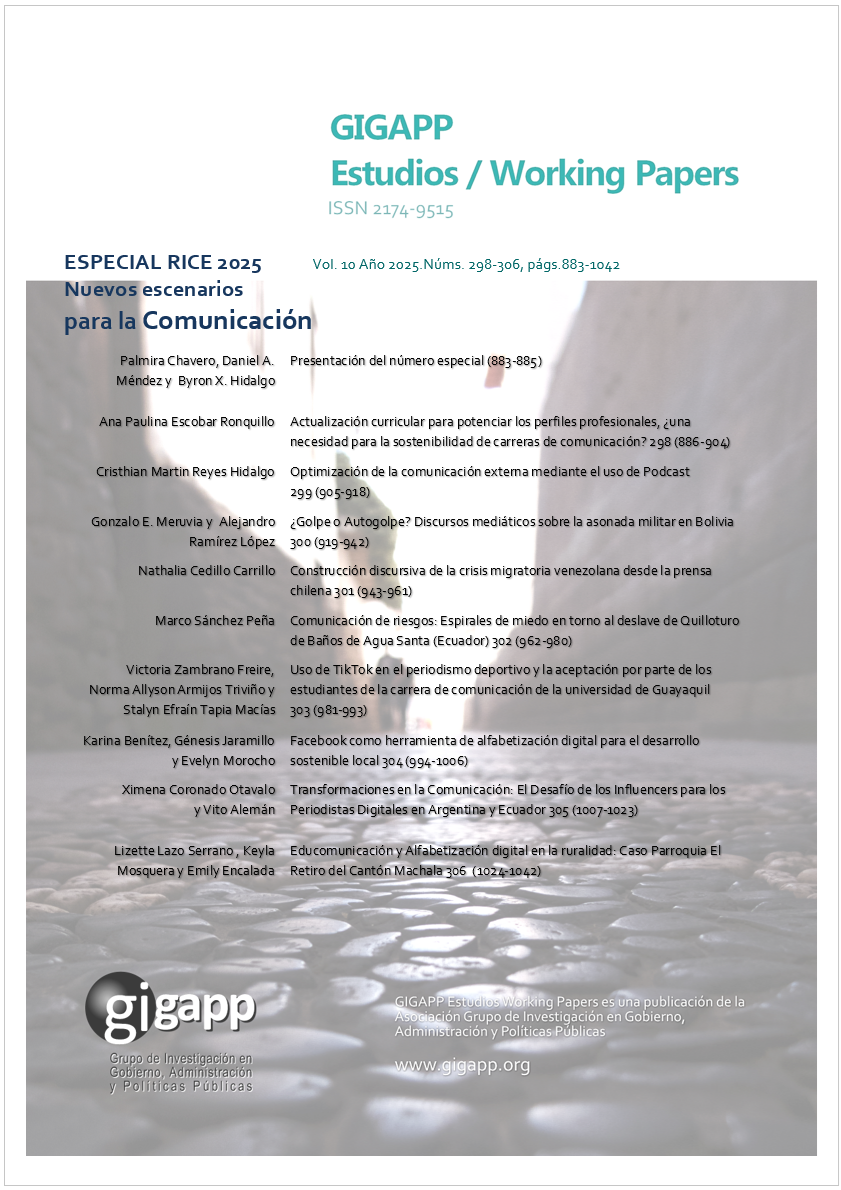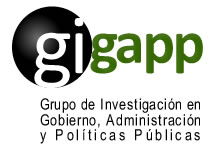Uso de TikTok en el periodismo deportivo y la aceptación por parte de los estudiantes de la carrera de comunicación de la universidad de Guayaquil
Resumen
El uso de TikTok en la creación de contenido deportivo ha emergido como una herramienta llamativa para los estudiantes de Comunicación de la Universidad de Guayaquil. Este análisis se centra en evaluar cómo TikTok aporta a la creación de contenidos deportivos y su aceptación por parte de los estudiantes. Objetivo: Analizar la influencia de la red social TikTok como herramienta de desarrollo de contenido deportivo para los estudiantes de comunicación de la Universidad de Guayaquil. Metodología: Se realizó una encuesta dirigida a 120 estudiantes y 3 entrevistas a expertos para conocer su percepción sobre TikTok en el ámbito del periodismo deportivo. Resultados: Los resultados indican que el 45% de los estudiantes pasan entre 0 y 30 minutos en TikTok, y un 38% considera que la plataforma es útil para compartir contenido deportivo de manera interactiva. Además, el 55% cree que TikTok facilita la conexión entre el periodismo deportivo y los aficionados. Sin embargo, existe una necesidad de mejorar el rigor periodístico, ya que algunos estudiantes aún presentan dificultades para mantener la precisión en sus contenidos.
Descargas
Citas
Álvarez, J., & Quito, J. (2020). Análisis de la práctica profesional del periodismo deportivo en me-dios de Cuenca. Universidad de Cuenca. https://dspace.ucuenca.edu.ec/bitstream/123456789/33651/3/Trabajo%20de%20Titulacion.pdf
Arias, S., Zamora, J., & Sanahuía, G. (2023). Deporte y TikTok: tipología de contenidos de los depor-tistas españoles en los Juegos Olímpicos de To-kio 2020. Ámbitos: Revista Internacional de Comunicación, 2023(60), 33-51. https://doi.org/10.12795/Ambitos.2023.i60.02
Benlloch, C. (2018). evolución de los medios de comunicación: Sensacionalismo e interacción. bpo-litics, la Revista de beers&politics, 3(5), 48-53. https://beersandpolitics.com/wp-content/uploads/2020/01/Evoluci%C3%B3n-de-los-medios-de-comunicaci%C3%B3n.-Sensacionalismo-e-interacci%C3%B3n-Claudia-Benlloch.pdf
Expósito, A., & Muñoz, N. (2021). Periodismo en TikTok: estudio de casos de los medios de comuni-cación españoles. Universidad de La Laguna.
García, A., Martínez, E., & Bonales, G. (2022). TikTok y Twitch, nuevos medios y fórmulas para im-pactar en la Generación Z. Dialnet, 20(1), 1-12. https://dialnet.unirioja.es/servlet/articulo?codigo=8217300
Gómez, J., & Mera, M. (2023). La evolución de la comunicación humana en las plataformas digita-les. Polo del Conocimiento, 8(1), 632-646. https://doi.org/10.23857/pc.v8i1
Gómez, K., Mendoza, J., & Zambrano, K. (2021). Evolución de medios nativos digitales de Ecuador en 2021: estudio de la Posta y GK. Revista San Gregorio, 2021(48), 113-122. https://doi.org/http:10.36097/rsan.v0i48.1968
Guerrero, D. N., & Castro, R. (2022). TikTok como herramienta para el periodis-mo alternativo: caso de estudio Ac2ality en Español. Guayaquil: Uni-versidad Católica del Ecuador. http://repositorio.ucsg.edu.ec/bitstream/3317/17767/1/T-UCSG-PRE-FIL-CSS-299.pdf
Guette, M. (2022). El deporte como intervención de tejido social para la paz. AVFT, 5(2), 1-8. https://www.revistaavft.com/images/revistas/2019/avft_5_2019/25_eldeporte.pdf
Lado, S. (2 de agosto de 2021). Universidad Isabel I. www.ui1.es: https://www.ui1.es/blog-ui1/importancia-de-las-redes-sociales-en-el-periodismo
Martínez, M., & Carrasco, R. (2024). Interacciones en las redes sociales virtuales: una revisión siste-mática de la literatura. Revista Fuentes, 26(1), 1-12. https://doi.org/https://doi.org/10.12795/revistafuentes.2024.22046
Miranda, Y. (2022). La evolución de los medios masivos de comunicación a las redes sociales digita-les y su estrategia comunicacional. Universidad Mayor de San Andrés.
Mudra, I., & Kitsa, M. (2022). What, How and Why? TikTok as a promising channel for media pro-motion. Media Literacy and Academic Re-search, 5(2), 225-237. https://www.mlar.sk/wp-content/uploads/2022/12/14_Iryna-Mudra_Mariana-Kitsa-.pdf
Ortega, G. (2022). Filosofía del deporte. Universidad de Catalunya. https://openaccess.uoc.edu/server/api/core/bitstreams/a543d1b4-8f92-4201-beb6-dfaca7f833ea/content
Ramón, R. (2021). Evolución, Historia y Comunicación en un Mundo Digital. Anthropos.
Rodríguez, M. (2013). El rol del periodista deportivo y su influencia en la prác-tica del deporte en la provincia de Santa Elena, 2012. Universidad Estatal Provincia de Santa Elena.
Rojas, J. (22 de julio de 2023). El Periscopio. mip.umh.es: https://mip.umh.es/blog/2023/10/16/tiktok-marca-relevo-medios-deportivos/
Romero, M. (2022). Las redes sociales como el nuevo mercado para el periodis-mo deportivo. Abya-Yala. https://doi.org/https://doi.org/10.7476/9789978108277.0004
Tapia, S. (2024) Uso de TikTok en el Periodismo Deportivo y su Influencia en el Desarrollo Profesio-nal de los Estudiantes de la Carrera de Comuni-cación de la Universidad de Guayaquil
Torres, Á., & Rojas, J. (2023). Periodismo deportivo en Iberoamérica. Universi-dad Politécnica Sale-siana. https://dspace.ups.edu.ec/bitstream/123456789/25253/4/PERIODISMO%20DEPORTIVO%20EN%20IBEROAME%CC%81RICA.pdf
Valbuena, N. (2023). Periodismo Digital: Una era de cambios en el periodismo tradicional. PerDe-bate, 7(1), 1-12. https://revistas.usfq.edu.ec/index.php/perdebate/article/view/3049/3543
Zamora, F. (2023). Evolución del uso del TikTok en el fútbol español. Estudio comparativo 2021-2023. Obra Digital, 2(24), 73-91. https://doi.org/https://doi.org/10.25029/od.2023.385.24
Zapata, M. (2023). El rigor periodístico en la generación de contenidos digitales. Dialnet, 1-12..
Derechos de autor 2025 Victoria Michelle Zambrano Freire, Norma Allyson Armijos Triviño, Stalyn Efraín Tapia Macías (Autor/a)

Esta obra está bajo licencia internacional Creative Commons Reconocimiento-NoComercial-CompartirIgual 4.0.
Aquellos autores/as que tengan publicaciones con esta revista, aceptan los términos siguientes:
a. Los autores/as conservarán sus derechos de autor y garantizarán a la revista el derecho de primera publicación de su obra, el cuál estará simultáneamente sujeto a la Licencia de reconocimiento de Creative Commons Attribution-NonCommercial-ShareAlike 4.0 International (CC BY-NC-SA 4.0) que permite a terceros compartir la obra siempre que se indique su autor y su primera publicación esta revista.
Con esta licencia de acceso abierto, los lectores (usuarios) pueden:
- Compartir — copiar y redistribuir el material en cualquier medio o formato
- Adaptar — remezclar, transformar y construir a partir del material
Bajo los siguientes términos:
-
Atribución — usarios deberán dar crédito de manera adecuada, brindar un enlace a la licencia, e indicar si se han realizado cambios. Puede hacerlo en cualquier forma razonable, pero no de forma tal que sugiera que usted o su uso tienen el apoyo de la licenciante.
-
NoComercial — usuarios no puede hacer uso del material con propósitos comerciales.
-
CompartirIgual — Si remezcla, transforma o crea a partir del material, usuarios deben distribuir su contribución bajo la misma licencia del original.
-
Sin restricciones adicionales: los usuarios no pueden aplicar términos legales o medidas tecnológicas que restrinjan legalmente a otros de hacer cualquier cosa que permita la licencia.
b. Los autores/as podrán adoptar otros acuerdos de licencia no exclusiva de distribución de la versión de la obra publicada (p. ej.: depositarla en un archivo telemático institucional o publicarla en un volumen monográfico) siempre que se indique la publicación inicial en esta revista
c. Se permite y recomienda a los autores/as difundir su obra a través de Internet (p. ej.: en archivos telemáticos institucionales o en su página web) antes y durante el proceso de envío, lo cual puede producir intercambios interesantes y aumentar las citas de la obra publicada. (Véase El efecto del acceso abierto).



